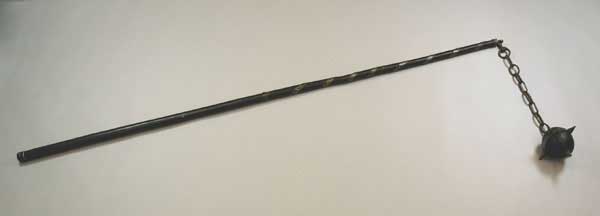Hinged (V7)
From the Rulebook
Hinged

Weapons with a single articulating (chain-like) head. The chain of a hinged weapon is not a legal striking edge. Chains on these weapons must be wrapped in foam with less than half an inch of rope exposed at any point. The combined rope and striking edge of a flail may not exceed 18 inches in length and the total length of the weapon may not exceed 36 inches. The top 50% of the non-rope and strike legal portion must be padded.
About hinged weapons
The flail is a medieval weapon made of one (or more) weights attached to a handle with a hinge or chain. There is some disagreement over the names for this weapon; the terms "morning star", and even "mace" are variously applied, though these are used to describe other weapons, which are very different in usage from a weapon with a hinge or chain, commonly used in Europe from the 13th century to the 15th century. In construction, the morning star and flail have similar, if not identical, spiked heads. Thus, morning star is an acceptable name for this weapon, especially as the name "flail" is also used to describe a style of whip used for flagellation. The term "morning star" actually refers to the head of a weapon[citation needed] (the small round spiked ball) and can be used for either a morning star mace (on a shaft) or flail (if on a chain). Flails also sometimes had blunt round heads or flanges like a mace. Some written records point to small rings attached to chains on a flail used to inflict greater damage, but no historical examples are known to exist.
The martial flail began as a variant of the normal agricultural flail. The term "flail" was given first to a farming implement used to separate wheat from chaff. This was normally a block of wood attached to a handle with either leather or rope. It was probably farmers called up for military service or peasant rebels who discovered its usefulness as a weapon. A few added spikes made the flail even more dangerous. The Hussites fielded large numbers of peasant soldiers with flails.
Later, special military flails were made, such as the iconic short stick with the chain and spiked metal ball. A mace and chain is a type of infantry weapon, most commonly used during the Middle Ages. It consists of a mace or morning star, only with the handle replaced by a chain, which itself connects to a shorter handle. Soldiers using a mace and chain grasped this short handle with either one or two hands, and swung the weapon at the enemy in battle. Soldiers could swing the mace in a circle to gain momentum, before releasing it on the enemy. This would cause major damage to an enemy.
Combat carateristics
Unlike a sword or mace, it doesn't transfer vibrations from the impact to the wielder. This is a great advantage to a horseman, who can use his horse's speed to add momentum to an underarmed swing of the ball, but runs less of a risk of being unbalanced from his saddle.
It is difficult to block with a shield or parry with a weapon because it can curve over and around shields or armor.
The flail needs space to swing and can easily endanger the wielder's comrades.
Controlling the flail is much more difficult than rigid weapons.
If the flail was swung with enough force it could crack open plate armour and stun the wearer.